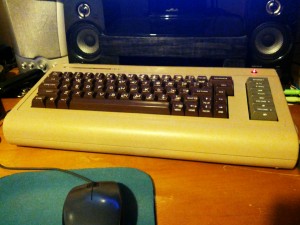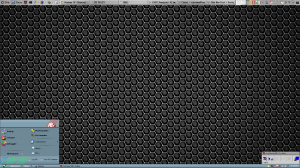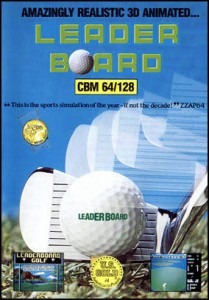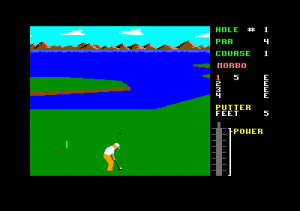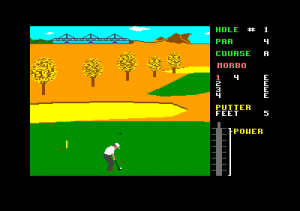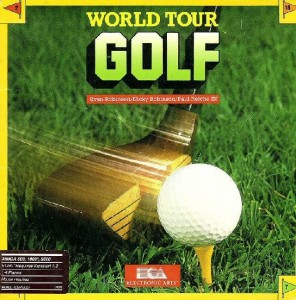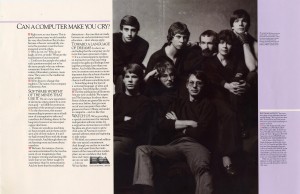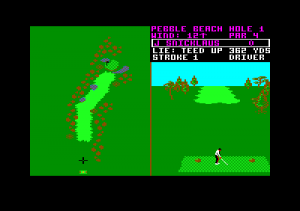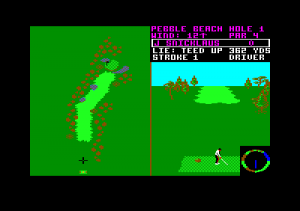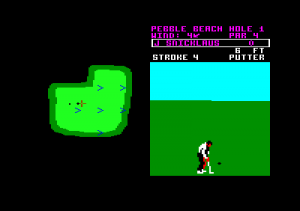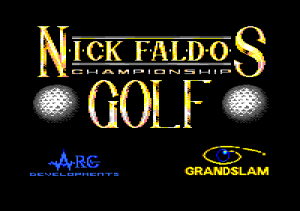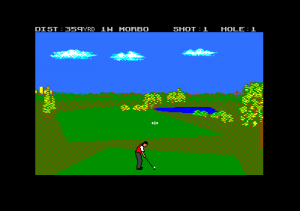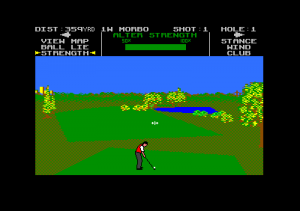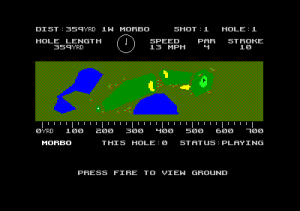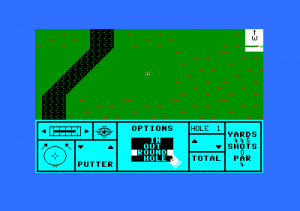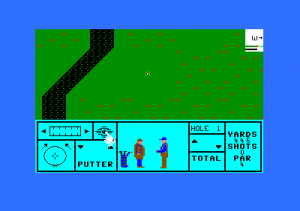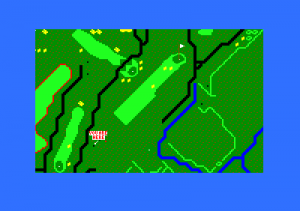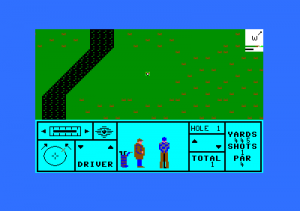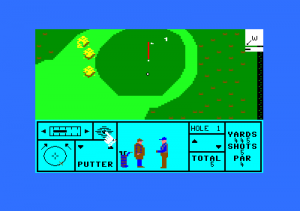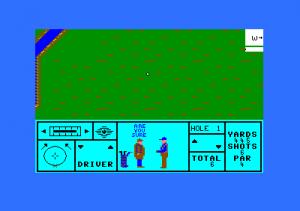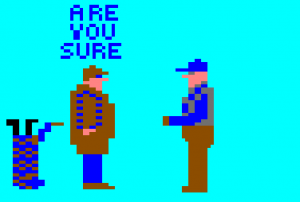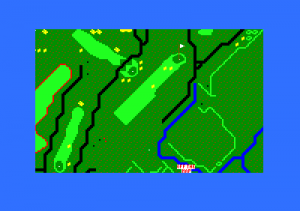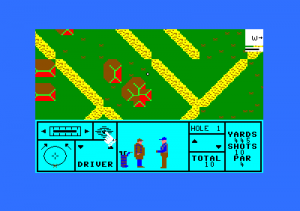I adore my 64, my Commodore 64.
Considering how I use (and am typing this on) a replica Commodore 64…
and how both my Linux desktop and the virtual Windows XP desktop I run inside it are themed to have a Commodore/Amiga look…
You could say I’m a fanboy. And as you might have guessed, the Commodore 64 was the first computer I owned when my father bought one for me and my brothers back around Christmas 1985. Like I wrote in the Apple II post below, home computers allowed their users to make their own games rather than relying on publishers to make them, so there were many tens of thousands – if not hundreds of thousands – of games made for the Commodore 64.
And it has plenty of golf games. When I was young, I only had one of these that I remember well. It was “Nick Faldo Plays the Open”, and I remember it as being a rather dull game. All I remember about it was the top-down view and the fact that you could whack a ball way the fuck off the map. For my 13 year old self, this was all kinds of hilarity, and after being disappointed with playing the game “straight”, I had literally minutes of enjoyment by just blasting the ball out into the parking lot. I wish I could find the game somewhere so I could remind my adult self just why I found this fun. It sounds quite idiotic, to be honest.
In any case, the Commodore 64 had a huge amount of RAM memory for a home computer when it came onto the market. Jack Tramiel, may he rest in peace, was a very smart man and he knew that RAM prices would eventually fall. By the time sales started taking off, RAM prices did fall and Commodore ended up selling millions of Commodore 64s. It is still the highest selling single home computer model of all time.
Its processor was no slouch too, and it could handle displaying and moving sprite graphics around the screen as well as any video game console around at the time. It’s sound chip was the first truly musical sounding hardware to be found in any home computer or video game system, and there is still music being produced with the SID Chip to this day.
Okay, sorry for going all fanboy on you. But Commodore’s marketing absolutely sucked. They made some pretty terrible business decisions too, which meant that they took a lead position with the best home computer around and turned it within a matter of years into bankruptcy. I’ll have more information to follow on that sad debacle in the Amiga section.
For now, let’s take a look at some of the better golf games for the venerable old “breadbox”.
From 1986 comes “Leaderboard Golf”, and this game is quite well known to any C64 fan. It’s one of the best games you can get for this computer, and it’s in my top 5 favourite golf video games of all time. I’d say it ranks at #4, just two spots behind ”Chip Shot Super Pro Golf” for the Intellivision.
Here’s what you see when you get past the option screens and start the gameplay:
It’s important to note that this isn’t a pseudo-3D view. This game actually renders the course in 3D. It’s rather slow to do it, but not horribly so. Of course, we already have lots and lots of factors to consider and lots of options to help make the most of our swing. Most Commodore 64 joysticks had but one button, and this game is programmed to use one button. But the controls are intuitive and very effective. Moving the joystick left-to-right will aim your shot. Up and down will select your club, which are more important in this game than in a lot of other games. When you have aimed and chosen the right club, press and hold the button. You will see the power meter rise. Release the button when the meter is where you want it to be. You will then see another meter fall, and you must press the button again to begin the swing at the right point on that meter.
Not much different from many other golf games. The only difference between this one and others is the way the meter is graphically represented. Either way, it works, and the ball physics are extremely realistic too. Everything else is quite easy to see and track on the screen. The fairway, the water, the sand, the trees – they all look more or less how they’re supposed to.
When you land a ball on the green, you automatically switch to using your putter and the swing meter changes its appearance:
Note the flag on the grass. We’re starting to see some real-looking eye candy in these games. Aiming is quite crucial here as your ball will have a tendency to hit the rim of the cup and get flung away from the hole if you’re not careful.
The sounds coming from this game are also very realistic. One of the advantages the SID chip had over sound chips found in other computers and game systems is that it allowed very fine-grained control over its output. The Commodore 64 had 4 voice channels, meaning that the SID could output 4 distinct waveforms of sound at once. normally this was used to make music and sound for games and entertainment that used each of the four voices as just that – a distinct voice or part of sound playing something different compared to what the other voices were playing.
But by clever programming, the four voices could be programmed to be manipulated in such a way as to produce some extremely realistic digital versions of actual sounds. SAM the speech synthesizer is a perfect example of this. The swoosh of the club, the sail of the ball through the air and the drop of the ball in the cup all sound as real as can be on a computer from 1982.
Shortly after this release came “Leaderboard Golf: Executive Edition”, which (as far as I can tell) doesn’t have any changes in gameplay but does have different courses and artwork.
If it ain’t broke, don’t fix it, right?
So, if you’re a nerd from the 80s like me, I highly recommend searching this one out and downloading it. It’s great fun, and it’s challenging in a good way. Grab yourself the VICE or CCS64 emulator and give it a whirl, because it’s great fun. If you decide to download the game, make sure you get .d64 files only. There are some .tap and .nib files that won’t work with these emulators.
Onto the next game.
The first thing that I have to get off my chest is that this game was released in 1987 by Electronic Arts. Mini-rant starts now. Today, EA is basically Satan. There’s nothing artistic about this company, and they (probably) kill kittens and puppies and cause Christmas to be canceled for crippled and starving children on a regular basis. But back in the 1980s, there were actually decent people running Electronic arts, and believe it or not, when you saw this logo:
You knew you were about to play a good game. You knew you were in for a treat, and that the game that was loading was a very well-made piece of software that had been expertly crafted by people who genuinely cared about what they did. Check out this famous magazine ad from 80s EA:
That’s a pretty stark comparison when it’s held up to what EA has become. Today their business model is to fuck over their customers and rip them off to whatever extent they can get away with. Art? What’s that?
Okay, end mini-rant.
“World Tour Golf” features a hybrid top-down and 3D view. This is the first golf game I’ve seen like this and so far it’s the only one that comes to mind.
The game is also fairly advanced as far as features go. Like other games from around this time, you must consider the wind and even other weather factors. While loading the first hole for instance, I was told that it was sunny yesterday, so my ball will travel along the dry grass easily.
The joystick controls aim (left and right) and club selection (up and down). In this game, club selection is crucially important. You start off with your driver when the ball is on the tee, but you will get absolutely nowhere fast if you try to continue using your driver when the ball is on the fairway or in the rough. Club selection also plays a major part in how far your ball will fly, even when considering how hard you swing, so be sure to choose the appropriate club.
Unfortunately, the aiming isn’t as fine as it could be. At the first hole, I’m standing looking straight down the fairway and I’d like to turn slightly to the right in order to get my ball to follow the curve of the course. But one push of the joystick will have me off into the rough, and there is no in-between. I think I know why such granularity was taken out of aiming. The 3D course view is rendered anew each time the ball is aimed so that the view will always correspond exactly with the direction of swing. On a Commodore 64 this can take some time, but it’s really not that long to wait. It’s about a second.
In any case, once you are ready to swing, you press the button. A circular power meter appears in the lower right of the screen. Pressing the button again will start the “needle” off in a clockwise direction. You must press the button twice more – once at the top of your swing to indicate the level of power, and once at the bottom to indicate where you strike the ball. As with most golf games, the closer you are to the “lines” that mark the power meter, the better. This game in particular is quite unforgiving when you press the button outside the lines, and your swing will suffer badly for it.
Once you have made it on to the putting green, the hybrid view zooms in.
The blue arrow signs on the green indicate slope. Aiming is accomplished by moving the joystick left and right, and you are automatically given your putter. The power meter now requires one button press less, as is common with most golf games.
The sounds in this game aren’t nearly anywhere as good as the ones in “Leaderboard”. Considering how great that game is, this one looks kind of unfinished by comparison. The power meter in particular looks terrible. And this came from a reputable game publisher that was renowned for making excellent games that pushed the envelope for quality. (Not being sarcastic here, see the mini-rant above.)
So if you already have this game, go ahead and give it a whirl. Otherwise, you’re not missing that much if you skip it. It’s a competent game for the Commodore 64 but after the tour de force that is “Leaderboard Golf”, it falls kind of flat. Oh, and that font looks fucking terrible.
Next up, from 1992 is “Nick Faldo’s Championship Golf”
Now, this being released in the 90s, we’re going in with some high expectations for the quality of this thing. Golf is golf, displays are displays and joysticks are joysticks. By now we all should have agreed on what makes a good golf game, right?
So the first thing we see is that we have another 3D view. There are some data up top, but otherwise it’s pretty sparse. It took me a while to figure out that pressing joystick “up” gets you into this menu:
From here, you can access a lot more. There is an even more detailed top-down view available from this menu:
In fact, you need to be in this menu to set up your shot. You need to select your club from here, choose the shot strength from here – do everything but aim the shot from here.
I can see that they were going for a different approach with the interface on this one. I’ve never seen anything quite like it for a golf game. Unfortunately, it makes playing this game pretty tedious after a while. The Commodore 64 had a keyboard for crying out loud, they could have made access to these controls a hell of a lot easier and instantaneous by making them key-activated.
It’s kind of a shame, because otherwise the graphics are nice. This just isn’t a golf game I can get into. If no other golf game had come before or since, and I learned these cumbersome controls by heart, then I might enjoy the game. But sadly, this game isn’t worth getting into.
Oh, and don’t ask me about the putting green because I never made it that far.
And now look what I’ve found!
It’s that “crappy” game that I had when I was a kid. Let me play it and do a proper review of it now that I understand the game of golf as an adult. I might just enjoy it, you never know. While I’m doing that, check out the stunning babealicious babes that Commodore nerds like me used to get back in the day.
Okay, I’m back. Well, that was a little different than I remember it to be about 25 years ago. So this is “Nick Faldo Plays the Open” from 1986. Keep in mind that this is the same year that “Leaderboard Golf” was released, and on the same computer too.
It looks a little sparse, but remember that “”Chip Shot Super Pro Golf” has a similar low-tech look and it’s a flat-out awesome game.
Once you select what type of game you want to play, you get a portrayal of you and your caddy in the interface:
If that’s Nick Faldo, then my oh my, has he ever put on some weight. His caddy sure has. I’m glad they’ve decided to walk the course in that case. It’s good for these portly fellas to try to get back into shape.
That icon that your white hand cursor is currently on is the map icon, and pressing the button now will show you the course map:
Pretty neat. The hole with the flag is the hole you’re currently on, so when you release the joystick button, you need to adjust the aim accordingly. The aim control is that circled cross with the two arrows above it on the bottom left corner. The aim control is also rather bad. Pressing the button moves it too far. Couldn’t they had made the little grey X move a lot more slowly to allow you to have better control?
Honestly, we haven’t even made a shot yet and we’re not off to a very good start.
But once you do aim, you need to select a club and then use the power meter to provide the appropriate amount of strength to your swing. To start the swing, move the cursor back to the image of the golfer and click on him.
You’ll see a crude animation of the fatty caddy handing the golfer his club and the golfer taking a swing. The ball with then sail off in whatever direction you have chosen at whatever power you have determined. Hooray!
Getting the ball on the green doesn’t change the view or provide any special controls or visuals.
But I am pleased to report that I have successfully gotten the ball in the hole in this game now. I am certain that I have never done this before because I do not remember ever hearing the sound effect used for it. Remember how I said that “Leaderboard Golf” had very realistic sound effects? Well, this game uses a sound effect like a freaking Buck Rogers laser beam ray gun.
Very cartoony.
So my adult impression of this game is that it’s alright, but like the other Nick Faldo game I reviewed above it, I wouldn’t cross the street to play it. So let’s drive the ball right the fuck off the map like I used to do and see if it’s still fun!
The first thing you’ll notice if you try to aim away from the hole is that your caddy asks you are you sure.
Now let’s pretend for a moment that the golfer really is Nick Faldo and that he’s a PGA superstar. Who the fuck does this caddy think he is? If Nick fucking Faldo wants to drive the ball away from the hole, then that’s what Nick fucking Faldo is going to do! Look at that smug look on the caddy’s face.
Well, fuck him. I’m pretty sure our man Nick could take him in a fight anyway. Even with those extra pounds he looks like he’s carrying. And once you drive the ball way the hell away, you are rewarded with this text on the map view:
Damn, did I ever think this was funny when I was 13. Look, I made it into some hay and some barns!
That’s actually quite a bit of detail for the game designers to put into the “out of bounds” parts of this game.
Well, this last review is actually kind of embarrassing to me. It really isn’t that funny to keep driving a golf ball out of bounds while your long-suffering caddy keeps asking “Are you sure?” He’s just doing his job, I guess.
That’s all the Commodore 64 golf games I’m willing to review. After “Leaderboard Golf”, it was really all downhill, but these other games do have redeeming qualities. They’re not total wrecks like “Golf” for the Atari 2600 or “Miniature Golf” for the Atari 5200. WTF, Atari?
I’m sure I haven’t even scratched the surface of possible Commodore 64 golf games, but I shall move on.
